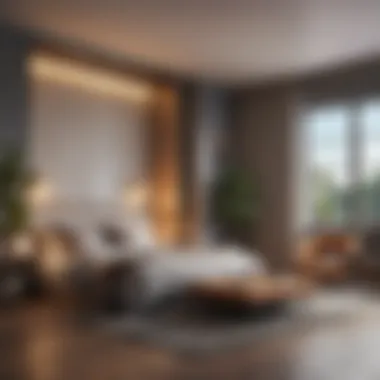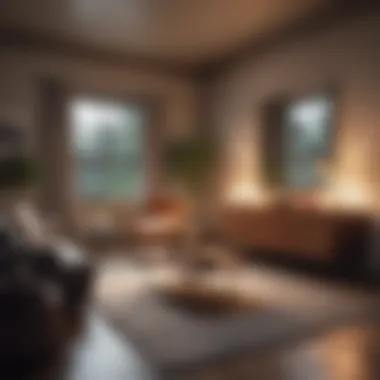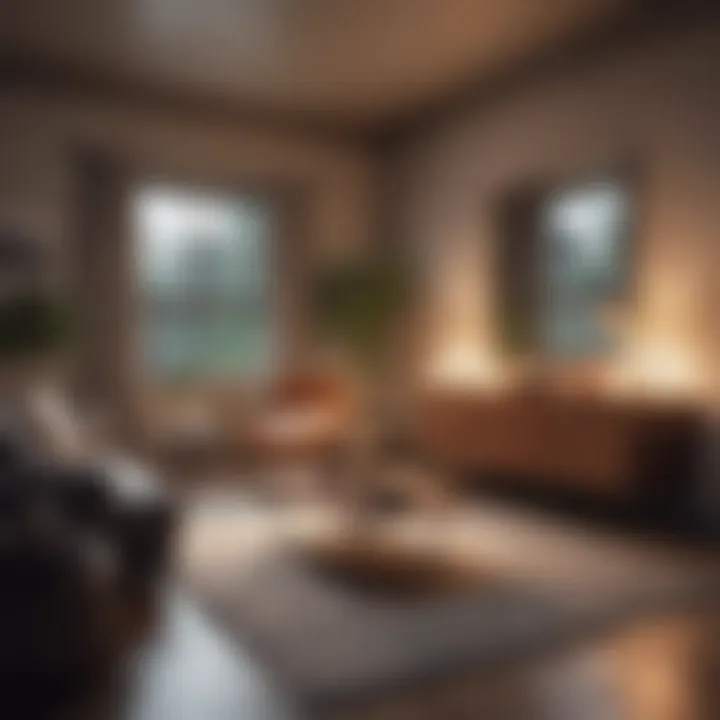Exploring Studio Apartments with Bedroom Configurations


Intro
As urban life continues to evolve, the concept of living spaces is also changing. The studio apartment has gained popularity due to its compact nature and potential for innovative designs. However, the emergence of studio apartments with dedicated bedroom configurations is a noteworthy trend that offers a blend of efficiency and comfort. This article will explore the significant aspects of such living arrangements, focusing on their design philosophies, space utilization, and impacts on modern living. By understanding these elements, we can better appreciate how these spaces have become appealing to various demographics including buyers, renters, and design enthusiasts.
Feature Spotlight
Exceptional Architectural Designs
Studio apartments with bedroom areas typically emphasize clever architectural layouts. Many designs incorporate open spaces while also creating distinct areas for living and sleeping. This is crucial for optimizing the available square footage.
A popular technique involves using partition walls or sliding doors to separate the bedroom from the main living area. This allows for a better flow of light while providing privacy without compromising the overall spaciousness. Architects often utilize multi-functional furniture like Murphy beds or extendable tables that can adapt to different needs, enhancing the apartment's functionality.
Moreover, design elements such as built-in shelving and alcoves make excellent use of vertical space, which is often underutilized in conventional apartments.
Unique Decor Elements
The decor within these studio apartments often reflects a minimalist aesthetic aimed at keeping spaces uncluttered. The use of neutral palettes combined with pops of color provides a modern yet inviting atmosphere.
In recent years, there has been a rise in the integration of sustainable materials in interior design, appealing to environmentally conscious renters and buyers. Elements like reclaimed wood, bamboo, or recycled metal add character and a personal touch to the decor.
Other significant trends include:
- Smart home technology: Integration of devices that manage lighting, climate, and security can enhance the living experience.
- Indoor greenery: Houseplants not only purify the air but also improve the aesthetic appeal of the space.
"The design of a studio apartment with a designated bedroom area can significantly affect how one experiences urban living. From layout to decor, these choices create a unique and personalized living environment."
Location Highlights
Must-Visit Neighborhoods
Choosing the right location for a studio apartment with a bedroom can greatly influence one’s lifestyle. Urban centers are becoming hubs for these innovative living spaces. In cities such as New York, San Francisco, and London, neighborhoods like Long Island City and Shoreditch are emerging as sought-after areas. Here, residents enjoy a rich array of amenities and cultural offerings while living in thoughtfully designed apartments.
Cultural and Historical Significance
The evolution of studio apartments reflects broader societal changes. As more individuals and families seek affordable housing solutions in urban areas, the demand for such configurations will likely grow. This shift towards compact living resonates with a growing emphasis on sustainability and efficiency. Understanding the cultural contexts of these neighborhoods adds depth to one’s appreciation of living in such spaces.
Prologue to Studio Apartments
Studio apartments have become an increasingly relevant topic in modern urban living. In densely populated cities, the demand for practical and efficient living spaces is rising. Studio apartments serve as an answer to this demand, offering compact solutions that can accommodate varied lifestyles. This section discusses the significance of understanding studio apartments, particularly those with designated bedroom areas, as they shape the way individuals perceive home.
Definition and Characteristics
A studio apartment is a self-contained unit that combines living, sleeping, and kitchen areas into a single space. Typically, it features an open layout, where walls between rooms are minimized or absent entirely.
Characteristics of studio apartments include:
- Open Floor Plan: The absence of separate rooms promotes an unobstructed flow of space, allowing for flexibility in furnishings and layout.
- Compact Size: These apartments usually range from 300 to 600 square feet, making them ideal for individuals or couples.
- Minimalist Design: With limited space, studio apartments often emphasize simplicity and functionality in both design and decor.
Understanding these characteristics aids potential residents in determining whether a studio apartment meets their housing needs. Factors such as space utilization, daily routines, and personal preferences play an integral role in this decision.
Increasing Popularity in Urban Settings
Studio apartments have witnessed a significant surge in popularity, particularly in urban areas. As city populations continue to grow, traditional housing options become less accessible, leading many to consider studios as viable alternatives.
Several factors contribute to this trend:
- Affordability: Studio apartments generally cost less than larger units, making them attractive to those on a tight budget.
- Location Benefits: Many studios are located in vibrant city centers, providing residents easy access to amenities, public transportation, and social hubs.
- Lifestyle Choices: A minimalistic lifestyle often reflects the desires of urban dwellers who prioritize experiences over material possessions.
As urban dynamics evolve, understanding the appeal of studio apartments becomes crucial for real estate enthusiasts and individuals seeking efficient, adaptable living arrangements.
"In an age where lifestyle is paramount, studio apartments offer a glimpse into the future of city living—where efficiency meets style."
By examining these elements, one gains insight into why studio apartments have become more than just a trend; they are slowly transforming the concept of home.
Understanding Studio Configurations
Understanding the concept of studio configurations is essential for those considering compact living arrangements, particularly in urban settings. The type of layout chosen can significantly impact how space is utilized and how residents experience their living environment. Different configurations offer distinct benefits, making it crucial to identify which elements align with your lifestyle.


Traditional Studio vs. Studio with Bedroom
A traditional studio apartment typically combines living, cooking, and sleeping areas into one open space. This design is intimate and maximizes floor area, allowing for flexibility with furnishings. With the popularity of minimalist lifestyle choices, many people find this arrangement appealing, as it minimizes excess and encourages simplicity.
In contrast, a studio with a separate bedroom configuration introduces a delineated sleeping space. This can greatly enhance both privacy and functionality. The physical barrier allows for better division of activities, which can lead to improved personal routines. It not only provides a defined area for rest but also allows for more diverse uses of the remaining space. For example, the main area can serve as a living room or office, depending on the occupant's needs.
When comparing both types, several key differences emerge:
- Privacy: A studio with a bedroom offers more solitude, ideal for those sharing space.
- Design Options: Having a separate bedroom opens up varied interior design opportunities, contributing to a more diverse aesthetic.
- Functionality: The separation of space can enhance functionality, allowing for distinct zones for relaxation and work.
Benefits of a Bedroom in a Studio Setup
Incorporating a bedroom into a studio apartment setup carries several compelling advantages. First, it enhances the overall living experience. The quiet space for sleeping promotes a better quality of rest, essential for maintaining mental and physical health.
Additionally, a bedroom can positively influence daily routines. It allows residents to keep sleeping areas distinct from activity zones, leading to a more organized and serene environment. This separation can be particularly beneficial for remote workers, as it creates a clear boundary between work and home life.
Moreover, the apartment's resale or rental potential may be higher with a dedicated bedroom. As people increasingly seek versatile living spaces, configurations that accommodate distinct functions could attract more interest.
The following highlights key benefits of opting for a studio with a bedroom:
- Enhanced privacy for occupants.
- Increased functionality and well-defined living spaces.
- Better potential for customization in design.
"Choosing the right configuration can transform a simple studio into a versatile living space."
Design Considerations for Studio Apartments
Designing studio apartments requires careful attention to detail. With limited space, every element needs to serve a purpose while still maintaining an aesthetically pleasing environment. The choices made in design have long-term implications for comfort and usability. This section will cover the fundamental aspects involved in creating a functional and inviting studio apartment with designated bedroom areas.
Space Management and Layout Strategy
Efficient space management is critical in a studio apartment. One must consider how to optimize the available square footage. Compact furniture pieces can save space while still being stylish.
Layout strategy is another vital aspect. Open floor plans are often favored, as they create a sense of flow. Utilizing modular furniture can allow areas to be reconfigured for various needs. Adequate circulation zones are important to make movement seamless.
Here are some key points to consider:
- Choose furniture that can be easily moved or rearranged.
- Use vertical space by incorporating shelving or tall cabinets.
- Consider placing the bed in a corner to free up more central space.
Zoning Techniques for Functionality
Zoning techniques allow the differentiation of spaces within a studio without physical barriers. This can significantly enhance functionality. Techniques such as rugs can delineate areas for sleeping, dining, and working.
Furniture arrangement also plays a role in zoning. Positioning a sofa with a low back can visually separate the living space from the bedroom area without creating a closed-off environment.
Consider the following methods:
- Use screens or curtains to create temporary privacy when needed.
- Designate a specific area for work to encourage productivity.
- Incorporate multifunctional furniture that adapts to various usage scenarios.
Color Schemes and Aesthetic Choices
Color schemes can dramatically affect the perception of space. Lighter shades often make areas feel larger and more open. Conversely, darker colors can create an inviting atmosphere but may overwhelm a small space if overused.
Incorporating a cohesive color palette helps unify different areas, enhancing flow throughout the studio. Thoughtful pairing of colors with textures can further enrich the visual experience.
Considerations for color choices:
- Stick to a maximum of three primary colors to maintain harmony.
- Use darker shades as accents to add depth without making the space feel smaller.
- Consider the finish of paint; a matte finish can give a softer look compared to glossy options.
"Effective design combines functionality with aesthetics, ensuring both comfort and style in confined spaces."
As urban living spaces continue to evolve, the importance of these design considerations cannot be understated. Thoughtful planning allows for a lifestyle that balances practicality with personal expression, particularly in studio apartments with designated bedroom areas.
Furniture Selection for Studio Living
Selecting the right furniture is crucial in studio living. Effective selection not only maximizes the space but also enhances functionality and aesthetic appeal. In a studio apartment, where every square foot counts, thoughtful furniture choices become more than an aesthetic decision. They shape daily living experiences and influence how one interacts with their environment. Therefore, potential buyers and renters should consider several key factors in their furniture selection process.
Multi-functional Furniture Options
Multi-functional furniture stands out as an essential aspect of studio living. These pieces serve dual or even multiple purposes, allowing residents to optimize limited space. For example, a sofa bed provides a cozy seating area by day and a comfortable sleeping space by night. Dining tables that extend can accommodate guests when needed but retract to save space when not in use.


Beyond practicality, these options can also contribute to an inviting atmosphere. When choosing multi-functional pieces, it is advisable to focus on quality as well. Investing in well-made furniture guarantees longevity, therefore, reducing the need for frequent replacements. Incorporating modular furniture can also add flexibility to accommodate changing needs in the future.
Sizing and Proportion Considerations
When selecting furniture for a studio, sizing and proportion must be at the forefront of decision-making. Overly large furniture can make a small space feel cramped. Conversely, furniture that is too small may lack presence and functionality. It is vital to measure the available space accurately and make informed decisions about each piece's dimensions.
Additionally, maintaining visual balance is important. Taller furniture, such as bookshelves or cabinets, can draw the eye upward, creating an illusion of height in a studio. This strategy can help open up the space visually.
Planning layout also plays a significant role. For instance, placing larger items, like beds or sofas, along the longer walls can leave room for traffic flow and additional storage.
Decorative Elements and Personalization
Decorative elements in a studio apartment can give character to the space. Selecting the right decorative items can transform a generic space into a personalized home. Wall art, decorative pillows, and a curated collection of knick-knacks can bring warmth.
When choosing decor, consider not only the visual appeal but also how items impact the overall vibe. Cohesive color schemes and materials contribute significantly to this aspect. By prioritizing a unified look, one can create a harmonious environment that reflects personal style.
Personalization can also extend to furniture choices. Customizing certain pieces, such as slipcovers for sofas or tailored drapes, can help establish a unique identity in a small living area.
"The art of furniture selection in studio apartments lies in the balance between form and function. Each piece should serve a purpose while enhancing the overall design aesthetic."
In summary, furniture selection plays a pivotal role in studio living. Through multi-functional options, suitable sizing, and thoughtful decor, individuals can craft a living space that is both functional and reflective of their personal style. This attention to detail not only elevates the experience of living in a compact area but contributes to the broader trend of innovative urban design.
The Role of Natural Light
Natural light plays a critical role in the ambiance and functionality of studio apartments. For spaces that are often compact, maximizing light is essential. It influences not only the visual appeal but also the emotional well-being of the occupant. Bright, well-lit areas can enhance mood, create a sense of openness, and promote a more inviting atmosphere. In a studio with a designated sleeping area, how light interacts with different zones becomes even more significant.
Considerations around natural light should focus on window placement, size, and design elements that enhance illumination. Through careful planning, homeowners can create spaces that feel larger and more welcoming. Increasing the influx of sunlight can also reduce reliance on artificial lighting, which benefits both the environment and electricity bills.
"The right illumination transforms not just a room, but the experience within it."
Designing for Optimal Illumination
Designing spaces in a way that fully embraces natural light involves strategic positioning and planning. First, consider the orientation of the apartment. South-facing windows, for instance, receive the most sunlight throughout the day, making them ideal for maximizing brightness. This orientation supports the creation of an airy environment.
Also, selecting materials that reflect light can amplify illumination. Light-colored walls and furnishings absorb less light, enhancing brightness in the entire space. Using mirrors can also play a pivotal role. They can both reflect and distribute light, creating an illusion of depth in smaller areas.
In addition to material selection, open layouts contribute greatly to optimal illumination. By avoiding heavy partitioning, light can flow freely between the living and sleeping areas. This ensures that all zones remain bright and inviting at various times during the day.
Window Treatments for Versatility
Selecting the right window treatments is vital for controlling the amount of natural light entering a studio apartment. Treatments not only provide privacy but also allow for adaptability based on time of day and personal preference.
Options for window treatments include:
- Lightweight sheer curtains provide a soft diffusion of sunlight while maintaining a level of privacy.
- Roller shades can be adjusted to control light levels precisely, offering a modern solution for managing brightness.
- Blinds can also be a strategic choice, as they allow for precise control over incoming light. This is especially useful in a studio apartment where light levels can be adjusted depending on activities.
Evaluating Privacy in Studio Spaces
In the discussion of studio apartments, privacy can often be overlooked. However, the importance of evaluating privacy in studio spaces cannot be understated. When designing or selecting a studio apartment, privacy becomes a pivotal aspect that influences the overall living experience. In an environment where the living, sleeping, and working areas may overlap, establishing clear boundaries is essential for comfort and functionality.
Understanding privacy in studio spaces involves more than just physical separation. It encompasses emotional well-being and the ability to retreat from one's surroundings. As urban populations grow, and more individuals opt for these compact living arrangements, privacy becomes increasingly significant. It allows residents to maintain a sense of personal space and autonomy, even in an open layout.
Key considerations include:
- Layout design: Effective space planning can create distinct zones that offer privacy.
- Material choices: The use of soundproof materials can also enhance acoustic privacy.
- Furniture arrangement: Strategically placed furniture can create barriers without overwhelming the space.
The benefits of evaluating privacy in studio spaces are manifold. It contributes not only to comfort but also to productivity. As people work more from home, having a quiet and private area is crucial.
"An effective layout can dramatically improve the living experience in studio apartments by providing essential privacy."
Furthermore, privacy measures can boost property value. From a buyer’s perspective, an apartment that thoughtfully integrates privacy solutions can be more appealing.
Innovative Privacy Solutions
Innovative privacy solutions can transform a studio apartment into a comfortable haven. A variety of strategies can be employed to create private spaces within an open floor plan. Here are some effective approaches to consider:
- Sliding doors or partitions: They can be utilized to create flexibility for different needs. Closed for privacy, opened for larger gatherings.
- Bookshelves or room dividers: These can function as visual barriers while providing additional storage.
- Curtains or screens: Easy to install and can be a stylish addition. They pull across an open area to create a sense of separation.
- Different floor levels: Elevating one area can visually distinguish spaces, creating separation between a sleeping space and a living area.
Choosing the right solution depends on the layout and personal style preferences.


Acoustic Considerations in Design
Acoustic considerations play a critical role in ensuring serenity in studio apartments. Poor sound insulation can result in distractions, affecting day-to-day living. When evaluating privacy, sound becomes a key factor. Effective design must minimize noise pollution.
To enhance acoustic privacy, several strategies can be followed:
- Soundproofing materials: Installing sound-absorbing panels can significantly reduce noise.
- Appropriate flooring options: Carpets or area rugs can dampen sounds when walking.
- Door seals: They can prevent sound from escaping or entering through gaps.
Acoustic treatments not only improve privacy but also enhance the overall quality of life.
Case Studies of Successful Studio Designs
Examining case studies of successful studio designs provides valuable insights into how effective space utilization can be achieved. These examples showcase innovative layouts and design choices that enhance livability without compromising style. By understanding these practical implementations, potential renters or buyers can recognize achievable solutions within their own environments.
Urban Locations with Notable Examples
In urban settings, studio apartments are often crafted to maximize limited space while still delivering comfort and aesthetic appeal. Cities like New York and San Francisco serve as prime locations for such designs.
For instance, the DUMBO area in Brooklyn, New York, is known for its stylish studio units featuring large windows and open-concept layouts. The strategic use of glass walls creates an illusion of more space, all while allowing natural light to flow freely.
Another noteworthy example can be found in Cow Hollow, San Francisco. Here, studios incorporate clever storage solutions that keep the living area uncluttered. Murphy beds and built-in shelving are common, allowing homeowners to transition seamlessly from living spaces to sleeping areas.
Benefits of these designs include:
- Efficient use of space
- Enhanced natural lighting
- Integration of smart storage solutions
These elements help to create a harmonious living space that feels more expansive than its square footage might suggest.
Innovative European Designs
European cities also present fascinating examples of studio design. Countries like Sweden and the Netherlands have embraced minimalism, showcasing how compact living can be both functional and stylish.
In Stockholm, many studios are designed with a focus on sustainability and energy efficiency. These units often feature eco-friendly materials and smart technology that contribute to lower energy consumption. The aesthetic is clean and modern, aligning with the preferences of the urban dweller.
Additionally, Amsterdam reflects creativity with studio layouts that include multi-functional spaces. Many apartments are designed to be flexible, allowing homeowners to adapt the layout based on their daily needs.
Key takeaways from these European examples include:
- Emphasis on sustainability
- Flexibility in design
- Integration of innovative technology
The ongoing evolution of studio apartment designs in urban and European locations illustrates a commitment to maximizing space, enhancing quality of life, and addressing the needs of modern living. By analyzing these cases, one can glean valuable insights into the potential of studio apartments with dedicated bedroom areas.
Market Trends in Studio Apartments
Studying the market trends in studio apartments offers valuable insights for prospective buyers and renters. More urban dwellers are considering studio living due to changing lifestyles, economic pressures, and preferences for smaller living spaces. As cities grow denser, the demand for these configurations has risen significantly. Over the years, studio apartments with dedicated bedroom areas have become a preferred choice for individuals desiring both space and efficiency.
The trend toward flexible living arrangements reflects a shift in societal norms. Many people prioritize mobility and minimalism, leading them to opt for something smaller yet multifaceted. Investors and developers have recognized this demand, increasingly tailoring new projects to cater to this market's specific needs. This evolution reveals a broader acceptance of innovative housing models.
Demand and Pricing Analysis
An in-depth analysis of demand and pricing for studio apartments highlights significant factors influencing the market. Key demographics are driving this trend, notably young professionals and students. Their need for affordable living arrangements in prime locations fuels demand.
- Location: Studio apartments in central urban areas command a premium due to proximity to workplaces, entertainment, and amenities. The rise in remote work creates new areas of demand, particularly in emerging neighborhoods.
- Pricing Trends: Prices for studio apartments have seen fluctuations. In some cities, prices are increasing as demand exceeds supply. However, in regions with an oversaturated market, rent may stabilize or decrease slightly. Reviews from sources such as Reddit indicate that renters are weighing the cost-to-benefit ratio carefully in their search for suitable housing.
- Investment Opportunity: Investors view studio apartments as attractive due to their potential for high rental yields. The interest in co-living spaces has broadened, further promoting the studio concept.
"The market for studio apartments With bedroom configurations is not just a trend; it's a redefined approach to urban living."
Future of Studio Living
Looking ahead, the future of studio living appears promising. Urban landscapes will continue evolving, impacting how spaces are designed and utilized. Architects and designers are likely to embrace concepts that prioritize adaptability and flexibility. Some key points to consider include:
- Sustainability: As awareness of environmental issues increases, many future studio developments will incorporate sustainable materials and energy-efficient designs.
- Smart Technology: Integration of smart home technologies will become commonplace. This not only enhances convenience but also aids in optimizing space management.
- Community Spaces: There is a growing movement towards designs that foster community interactions. Many new projects are considering shared spaces in addition to the private units, enriching the living experience.
Overall, the market for studio apartments, particularly those with dedicated bedroom configurations, offers exciting prospects. The combination of shifting demographics, economic conditions, and innovative design will shape how these spaces evolve in the coming years.
Closure
The conclusion serves as a vital section that synthesizes the critical points outlined throughout this article regarding studio apartments with designated bedroom configurations. It sums up the significance of understanding the nuances that these living spaces present, especially in urban environments where space is at a premium. By exploring various attributes, such as design strategies and the intended functionality of layouts, we can appreciate how these configurations cater to modern lifestyle needs.
Summary of Key Insights
- Functionality and Space Efficiency: Studio apartments with bedrooms maximize utility in smaller living areas. The typical configurations offer a blend of comfort and practicality, making them ideal for city dwellers.
- Innovative Design Strategies: The integration of zoning techniques allows for distinct living areas without compromising the overall openness of the studio. This encourages a functional aesthetic that appeals to many renters and owners.
- Market Trends: The rising demand for such apartments highlights a shift in housing preferences, with many seeking cozier yet efficient spaces. As urbanization continues, this trend is expected to grow.
- Cost-Effectiveness: Studios often present a more affordable option compared to traditional one-bedroom apartments. This financial benefit cannot be overlooked in the current housing market.
- Personalization and Decor: The flexibility of design choices enables individuals to make the space their own, enhancing the appeal of studio living.
Final Thoughts on Embracing Studio Life
Embracing studio living, particularly those with bedroom configurations, invites a new way of experiencing home. For real estate enthusiasts, it presents a unique opportunity to explore properties that exemplify chic, modern living while retaining the essence of a cozy home. The balance of style, utility, and affordability makes these apartments a noteworthy consideration in today's market. Ultimately, understanding the dynamics of studio designs leads to richer, more informed decisions for potential renters and buyers alike.







